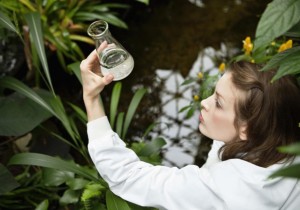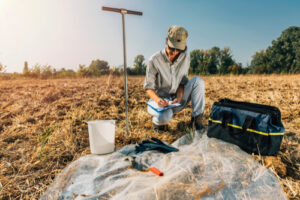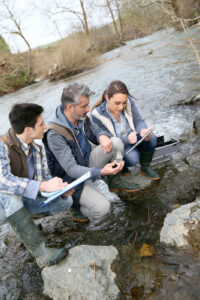
The world’s concern over air quality, global climate change, food safety, hazardous waste management, lead poisoning, water contamination, and toxic chemical exposure is continuing to rise steadily. Thus, the role of the environmental health scientist continues to grow in demand. Due to their expertise in studying how different environmental factors can affect human health and wellness, more businesses will need to consult with an environmental health scientist. This will allow them to cut waste, prevent pollution, conserve resources and limit land damage. In the end, it will allow them to protect human lives. In fact, employment of environmental health scientists is projected to grow faster than average. It could have a growth rate of 15% over the next decade, according to the Bureau of Labor Statistics. The demand for these professionals is not limited to a particular demographic or region. This makes it a great option for a career choice, as the job opportunities can be varying in nature.
In order to determine if this is the right career pathway for you, read on for a full job description for an environmental health scientist.
Simply put, the work of an environmental health scientist is to improve the health of the public. They do this first by identifying risk factors. They then use their education in the natural sciences to develop a plan to protect both the environment and the people. One part of the job of environmental health scientists is to educate the public about the potential health risks present in the environment. This can be done through creating accessible websites. Or it can be done by teaching others about pressing environmental issues, either in a classroom environment or through other resources. Additionally, environmental health workers have the responsibility to analyze pressing environmental problems. They then develop solutions with the goal of improving public health outcomes. For example, if dealing with pollution, an environmental health scientist will need to test and analyze soil, air, and water samples. Based on their findings, they then may need to find the source of the pollution. Finally, they determine what to do in order to insure the ultimate safety of those affected by the pollution.
The job of an environmental scientist can change from day to day. On a daily basis, an environmental health scientist may:
- collect data for research projects
- compile environmental samples for scientific analysis
- assess threats to the environment
- develop plans to prevent or fix environmental health concerns
- provide information to the general public on possible human health risks
- prepare presentations on their research findings.
From ensuring the air we breathe is clean, to keeping hazardous materials out of the soil, these scientists work to ensure health regulations are followed to decrease harm to the environment and general public.
Where Environmental Health Scientists Work

According to the Bureau of Labor Statistics, there are around 90,000 environmental scientists and specialists employed throughout the United States in various industries. Most environmental health scientists are employed by the federal, state, or local governments. However, there are also many types of work opportunities found in private consulting firms, engineering services, hospitals, public health departments, and scientific laboratories. Scientists specializing in environmental health often work in office settings and laboratories analyzing data on environmental conditions. Yet, some will need to travel frequently to present their findings. It is also worth noting that it is sometimes necessary for an environmental health scientist to engage in more demanding fieldwork. This type of work allows scientists to monitor the environmental conditions firsthand. The majority of scientists work full-time. Many work long irregular hours when working on specific environmental health problems in the field. The job can differ depending on location: office, laboratory, or the field. However, the great demand in the field of work often allows for environmental health scientists to choose their preferred work environment.
How to Become an Environmental Health Scientist

In order to obtain entry-level employment as an environmental health scientist, it is necessary to complete at least a bachelor’s degree program from an accredited institution. This degree should be with a major in environmental science or a related field. Biology, chemistry, geology, engineering, physics, hydrology, or other related natural sciences are acceptable choices for this. For advancement in the field, some scientists pursue a master’s degree. Others will continue to the doctoral degree level in order to participate in advanced research or to achieve higher academic positions. When choosing a master’s degree program, students have the opportunity to pursue an area of particular interest, as the field covers a broad range of areas. Specialization in a particular science can help when searching for the perfect job. It is recommended that when looking to supplement the coursework materials, an aspiring environmental scientist should participate in internships. This allows them to gain hands-on experience. They can work with computer modeling, geographic information systems, and data analysis for the best preparation to enter the competitive job market.
Related Resource: Public Health Outreach Specialist
Overall, environmental health scientists are on the forefront of the public health field. This exciting career allows scientists to focus all of their study efforts on identifying, analyzing, and addressing environmental risk factors that place human health in danger, according to the World Health Organization. The field is perfect for those with the desire to make a real difference in the lives of people today as well as those in future generations. For those who have a strong love of science along with solid analytical, communication, problem-solving, and technical skills, it is worth considering this ever-changing, exciting field. As we have noted, the job of scientists specializing in environmental health offers the opportunity to address relevant, pressing needs in the physical world. They then have the chance to do the work to make an immediate impact. This career needs research, analysis, planning, and the spreading of crucial information. It also needs workers who are willing to give their time and energy to improving the environmental factors of today. These actions will ensure a healthier, safer tomorrow.
Related Rankings:
- 10 Most Affordable MPH Programs That Don’t Require GRE
- Top 10 Master of Science in Public Health MSPH Degree Programs
- Top 10 MD MPH Programs
- 10 Cheapest MPH Degrees in California
Updated June 2022